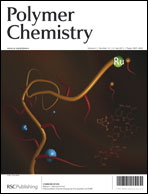Self-assembly of amphiphilic random co-poly(ionic liquid)s: the effect of anions, molecular weight, and molecular weight distribution†
Abstract
Self-assembly behavior of amphiphilic random co-poly(ionic liquid)s in aqueous solution was investigated in this work. An imidazolium-type homopolymer, poly(1-(4-vinylbenzyl)-3-methyl imidazolium chloride) (denoted as PIL-[Cl]), was synthesized via reversible addition fragmentation chain transfer (RAFT) polymerization of p-chloromethyl styrene, and followed by post-polymerization with methylimidazole (or vinylimidazole). Partial anion-exchange of PIL-[Cl] with PF6− anions yielded amphiphilic random copolymers, PIL-[Cl]x[PF6]y (suffixes x, y represent the relative molar ratio of Cl− and PF6− anions). Self-assembly morphologies of PIL-[Cl]x[PF6]y in aqueous solution as a function of copolymer composition (anions), molecular weight, and molecular weight distribution were investigated. The size of well-defined PIL-[Cl]x[PF6]y spherical micelles increased dramatically with increasing molecular weight distribution, while the anions and molecular weight show little effect on the micelle size. Furthermore, self-assembly of amphiphilic random ionic copolymers with the vinylimidazole groups yielded colloidosomes, which might be due to the polymerization of vinylimidazole groups.


 Please wait while we load your content...
Please wait while we load your content...